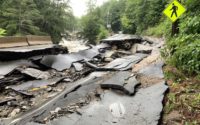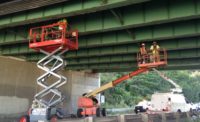Vermont and New Hampshire are assessing infrastructure damage and repair projects following late July storm flooding that could cost the states an estimated $6 million, officials say.
“Significant, serious flooding” was reported in Vermont with an estimated $5 million in infrastructure damage, according to a state Emergency Management spokesman.
“Current damage estimates are just shy of $5 million in direct replacement costs, but we expect that number to rise when all repairs are complete,” he says.
The storms that stretched from Manchester, Vt. to Bellows Falls, south to Putney, Vt. impacted the state''s southernmost Bennington and Windham counties, as well as affecting New Hampshire, from July 20 to July 30.
One line of storms pounded the area with five or six inches or rain in some cases, "while 10 to 15 miles to either side got comparatively little,” the Vermont spokesman notes.
The storms pummeled many public roads and culverts, and exposed some water system piping, but no homes or businesses were impacted, the spokesman says. In Putney, a 4-ft culvert washed away part of River Rd. “They are left with a gorge about 15 to 20 ft deep, 30 ft across, which took out the roadway,” he says. “That will be closed for months.” In Dummerston, south of Putney, “a tree knocked down a utility pole and blocked a bridge.”
Officials in Manchester, Vt. estimated damage to be about 60% of what it was during Hurricane Irene in 2011.
Ben Rose, Recovery and Mitigation Section Chief for Vermont Emergency Management, says he is “not aware of any specific sites or structures which were damaged in the recent storm which had been previously repaired after Tropical Storm Irene or after any other Federal Emergency Management Agency Public Assistance disaster for that matter. There may be some repeat sites out there, but not a lot.”
“Anecdotally, we have noticed during the 10 declared flood disasters since Irene that repairs undertaken have stood up very well to subsequent events,” he says. He attributes that largely to a combination of FEMA 406 hazard mitigation funding being applied on a case-by-case basis, upsizing of structures in line with Vermont’s General Stream Alteration Permit, and rebuilding to local transportation codes and standards.
Rather than fixing the same problem repeatedly, “we’re working hard to incorporate resilience in recovery from each new storm,” he says.
Neighboring New Hampshire also suffered significant storm damage, estimated at more than $1 million, says David Rodrigue, director of operations, New Hampshire Dept. of Transportation.
“Precipitation totals exceeded 16 to 19 inches in places that typically receive an average July precipitation of about 4.5 inches,” he says.
Localized rainfall amounts on July 29 approached or exceeded 4.5 inches in less than six hours, “considered to be in the neighborhood of a 200-year storm,” Rodrigue says. “This rain fell onto already saturated soils, and into swollen rivers and ponds.”
The state DOT and local road agents responded to washed out roads, failed drainage pipes, and washed-out bridge approaches. Crews worked through July 29 and July 30, Rodrigue says. Damage ranged from water flowing over roads, to heavily eroded and damaged roads that forced closures in several towns, including Walpole, Goshen, Alstead, Acworth, Lempster and Alton. “Two state bridges, one on Rt. 10 in Goshen, the other on R. 123A in Acworth—lost soil behind them,” he says.
An Aug. 4 SentinelSource.com report notes that farther east, the town of Jaffrey incurred more than $1 million in damage from July’s rain.
The areas of greatest concern for the agency were a 10-mile section of NH Route 123A “that was significantly damaged” and a portion of NH Route 123A in the town of Alstead “that was totally gone,” he says. The road is currently only open to emergency vehicles, Rodrigue says.
Following more rain on Aug. 2, a 300-ft slope slide developed on NH Route 12 in Charlestown leading to a roadway closure by mid-afternoon, Rodrigue says.
The two hardest hit NHDOT roadway failures—including NH Route 123A in Alstead and NH Route 12 in Charlestown—will require expedited design/bid/build contracts to construct final repairs, Rodrigue says. “Soils borings and engineering on these final repairs have already begun,” but it is too soon to predict the completion date or final cost, he says. “Normally the process takes close to a year, but we are tentatively trying to expedite something in the next four or so weeks on a very aggressive schedule.”
NHDOT is counting on Federal Highway Emergency Relief funding and FEMA reimbursement to help fund work that will easily exceed $1 million,” he says.
The Vermont Emergency Management spokesman says it is expecting towns to bid and repair roads before the winter.
“We are now doing preliminary damage assessments with FEMA … that will allow us to request a federal disaster,” he says. “That is expected to take 30 days for approval before the agency has to meet with towns to document every road that was damaged and its location. We’re confident we meet the threshold but need to go through the process.”
Meanwhile, New Hampshire's DOT has been working to repair roads, and has worked closely with NH Homeland Security and Emergency Management to process resource requests from communities, Rodrique says. “NH Public Works Association has a public works mutual aid program that communities can join and it allows for sharing of resources in times of need such as this,” he says.






Post a comment to this article
Report Abusive Comment